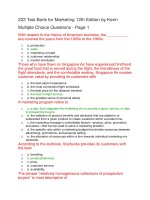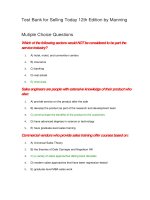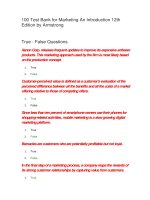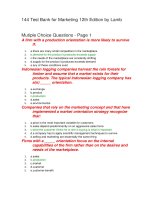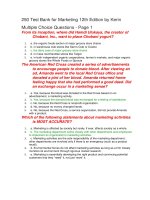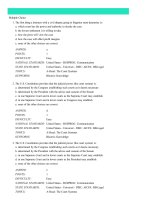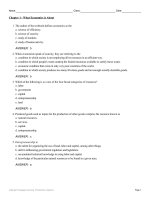Test bank microeconomics 12th edition by parkin
Bạn đang xem bản rút gọn của tài liệu. Xem và tải ngay bản đầy đủ của tài liệu tại đây (1.88 MB, 157 trang )
Test Bank Microeconomics 12th Edition by Parkin
Microeconomics 12th Edition Solutions Manual Michael Parkin
Solutions Manual, Answer key, Instructor's Resource Manual, Instructor's
Solutions Manual for all chapters are included download:
Microeconomics, 12e (Parkin)
Chapter 3 Demand and Supply
1 Markets and Prices
1) A relative price is the
A) slope of the demand curve.
B) difference between one money price and another.
C) slope of the supply curve.
D) ratio of one money price to another.
Answer: D
Topic: Price and Opportunity Cost
Skill: Recognition
AACSB: Reflective thinking
2) A relative price is
A) the number of dollars that must be given up in exchange for the good.
B) also called the money price.
C) not an opportunity cost.
D) the ratio of one price to another price.
Answer: D
Topic: Price and Opportunity Cost
Skill: Recognition
AACSB: Reflective thinking
3) The opportunity cost of good A in terms of good B is equal to the
A) money price of good A minus the money price of good B.
B) money price of good B minus the money price of good A.
C) ratio of the money price of good A to the money price of good B.
D) ratio of the money price of good B to the money price of good A.
Answer: C
Topic: Price and Opportunity Cost
Skill: Analytical
1
AACSB: Reflective thinking
4) The relative price of a good is
A) an opportunity cost.
B) equal to the money price of a good.
C) equal to the price of that good divided by the quantity demanded of the good.
D) what you get paid for babysitting your cousin.
Answer: A
Topic: Price and Opportunity Cost
Skill: Recognition
AACSB: Reflective thinking
2
5) The opportunity cost of a hot dog in terms of hamburgers is the
A) ratio of the slope of the demand curve for hot dogs to the slope of the demand curve for
hamburgers.
B) ratio of the slope of the supply curve for hot dogs to the slope of the supply curve for
hamburgers.
C) money price of a hot dog minus the money price of a hamburger.
D) ratio of the money price of a hot dog to the money price of a hamburger.
Answer: D
Topic: Price and Opportunity Cost
Skill: Analytical
AACSB: Reflective thinking
6) Joe pays $8,000.00 in tuition. The 8,000 dollar tuition Joe pays is an example of what
economists call
A) a relative price.
B) a money price.
C) an indexed price.
D) an opportunity price.
Answer: B
Topic: Price and Opportunity Cost
Skill: Conceptual
AACSB: Reflective thinking
7) If the price of a candy bar is $1 and the price of a fast food meal is $5, then the
A) relative price of a candy bar is 5 fast food meals per candy bar.
B) money price of a candy bar is 1/5 of a fast food meal per candy bar.
C) relative price of a fast food meal is 5 candy bars per fast food meal.
D) money price of a fast food meal is 1/5 of a candy bar per fast food meal.
Answer: C
Topic: Price and Opportunity Cost
Skill: Analytical
AACSB: Analytical thinking
8) If the price of a hot dog is $2 and the price of a hamburger is $4, then the
A) relative price of a hot dog is 1/2 of a hamburger per hot dog.
B) money price of a hot dog is 2 hamburgers per hot dog.
C) relative price of a hamburger is 1/2 of a hot dog per hamburger.
D) money price of a hamburger is 2 hot dogs per hamburger.
Answer: A
Topic: Price and Opportunity Cost
Skill: Analytical
AACSB: Analytical thinking
3
9) Suppose the price of a football is $20.00 and the price of a basketball is $10.00. The ________
of a football is ________.
A) relative price; 2 basketballs per football
B) relative price; 1/2 basketball per football
C) opportunity cost; $20.00
D) opportunity cost; $10.00
Answer: A
Topic: Price and Opportunity Cost
Skill: Analytical
AACSB: Analytical thinking
10) The price of a bag of corn chips is $3, and the price of a bottle of soda is $1. What is the
relative price of a bag of corn chips?
A) 3 bottles of soda per bag of corn chips
B) 1/3 bottle of soda per bag of corn chips
C) $3
D) 33¢
Answer: A
Topic: Price and Opportunity Cost
Skill: Analytical
AACSB: Analytical thinking
11) The price of a bag of corn chips is $3, and the price of a bottle of soda is $1. What is the
relative price of a bottle of soda?
A) 3 bags of corn chips per bottle of soda
B) 1/3 bag of corn chips per bottle of soda
C) $3
D) 33¢
Answer: B
Topic: Price and Opportunity Cost
Skill: Analytical
AACSB: Analytical thinking
12) An ice cream cone costs $1.50. A can of soda costs $0.75. The relative price of an ice cream
cone is
A) 1/2 can of soda per ice cream cone, the opportunity cost of an ice cream cone.
B) $1.50, the opportunity cost of a can of soda.
C) 2 cans of soda per soda, the opportunity cost of an ice cream cone.
D) $0.75, the opportunity cost of a can of soda.
Answer: C
Topic: Price and Opportunity Cost
Skill: Analytical
AACSB: Analytical thinking
4
13) Twenty years ago a stove cost $300 and a refrigerator cost $1,500. Today a stove costs $600,
while a refrigerator costs $1,800. Which of the following statements is TRUE?
A) The relative price of stoves and refrigerators has not changed.
B) The relative price of a refrigerator has increased.
C) The relative price of a stove has increased.
D) The money price of a refrigerator has fallen.
Answer: C
Topic: Price and Opportunity Cost
Skill: Analytical
AACSB: Analytical thinking
14) If the money price of wheat increases and no other prices change, the
A) relative price of wheat falls.
B) opportunity cost of wheat rises.
C) demand for wheat increases.
D) relative price of wheat is unaffected.
Answer: B
Topic: Price and Opportunity Cost
Skill: Conceptual
AACSB: Reflective thinking
15) If the money price of hats rises and no other prices change, the
I. relative price of a hat rises.
II. opportunity cost of a hat rises.
A) only I
B) both I and II
C) only II
D) neither I nor II
Answer: B
Topic: Price and Opportunity Cost
Skill: Conceptual
AACSB: Reflective thinking
16) The price of a DVD rental is $1.50 and the price of a downloaded movie is $1.00. If the price
of a DVD rental increases by $0.50, the relative price a downloaded movie
A) rises.
B) falls.
C) does not change.
D) might change but more information is needed.
Answer: B
Topic: Price and Opportunity Cost
Skill: Conceptual
AACSB: Reflective thinking
5
17) The price of a DVD rental is $2.50 and the price of a downloaded movie is $1.00. If the price
of a DVD rental falls by $0.50, the relative price a downloaded movie
A) rises.
B) falls.
C) does not change.
D) might change but more information is needed.
Answer: A
Topic: Price and Opportunity Cost
Skill: Conceptual
AACSB: Reflective thinking
18) The opportunity cost of a good is the same as its
A) money price.
B) relative price.
C) price index.
D) none of the above.
Answer: B
Topic: Study Guide Question, Price and Opportunity Cost
Skill: Conceptual
AACSB: Reflective thinking
19) The money price of a pizza is $12 per pizza and the money price of a taco is $2 per taco. The
relative price of a pizza is
A) $12 per pizza.
B) $24 per pizza.
C) 6 tacos per pizza.
D) 1/6 pizza per taco.
Answer: C
Topic: Study Guide Question, Price and Opportunity Cost
Skill: Analytical
AACSB: Analytical thinking
2 Demand
1) Wants, as opposed to demands
A) are the unlimited desires of the consumer.
B) are the goods the consumer plans to acquire.
C) are the goods the consumer has acquired.
D) depend on the price.
Answer: A
Topic: Demand
Skill: Recognition
AACSB: Reflective thinking
6
2) Demands differ from wants because
A) demands are unlimited, whereas wants are limited by income.
B) wants require a plan to acquire a good but demands require no such plan.
C) wants imply a decision about which demands to satisfy, while demands involve no specific
plan to acquire the good.
D) demands reflect a decision about which wants to satisfy and a plan to buy the good, while
wants are unlimited and involve no specific plan to acquire the good.
Answer: D
Topic: Demand
Skill: Conceptual
AACSB: Reflective thinking
3) Scarcity guarantees that
A) demands will exceed wants.
B) wants will exceed demands.
C) demands will be equal to wants.
D) most demands will be satisfied.
Answer: B
Topic: Demand
Skill: Conceptual
AACSB: Reflective thinking
4) The quantity demanded of a good or service is the amount that
A) a consumer would like to buy but might not be able to afford.
B) is actually bought during a given time period at a given price.
C) consumers plan to buy during a given time period at a given price.
D) firms are willing to sell during a given time period at a given price.
Answer: C
Topic: Quantity Demanded
Skill: Recognition
AACSB: Reflective thinking
5) The quantity demanded is
A) always equal to the equilibrium quantity.
B) independent of the price of the good.
C) the amount of a good that consumers plan to purchase at a particular price.
D) independent of consumers' buying plans.
Answer: C
Topic: Demand
Skill: Recognition
AACSB: Reflective thinking
7
6) When graphing a demand curve for corn, we are showing the relationship between the
quantity demanded of corn and the
A) money price of corn.
B) relative price of corn.
C) income effect.
D) substitution effect.
Answer: B
Topic: Law of Demand
Skill: Recognition
AACSB: Reflective thinking
7) The "law of demand" states that changes in
A) demand are related directly to changes in supply.
B) the quantity demanded of a good are not related to changes in the quantity supplied.
C) the quantity demanded of a good are inversely related to changes in its price.
D) demand are inversely related to changes in supply.
Answer: C
Topic: Law of Demand
Skill: Recognition
AACSB: Reflective thinking
8) The "law of demand" is illustrated by a
A) rightward shift of the demand curve.
B) leftward shift of the demand curve.
C) movement along the demand curve.
D) Both answers A and B are correct.
Answer: C
Topic: Law of Demand
Skill: Conceptual
AACSB: Analytical thinking
9) The law of demand states that, other things remaining the same, the higher the price of a good,
the
A) smaller is the demand for the good.
B) larger is the demand for the good.
C) smaller is the quantity of the good demanded.
D) larger is the quantity of the good demanded.
Answer: C
Topic: Law of Demand
Skill: Conceptual
AACSB: Reflective thinking
8
10) The law of demand states that the quantity of a good demanded varies
A) inversely with its price.
B) inversely with the price of substitute goods.
C) directly with income.
D) directly with population.
Answer: A
Topic: Law of Demand
Skill: Conceptual
AACSB: Reflective thinking
11) The "law of demand" refers to the fact that, all other things remaining the same, when the
price of a good rises
A) the demand curve shifts rightward.
B) the demand curve shifts leftward.
C) there is a movement down along the demand curve to a larger quantity demanded.
D) there is a movement up along the demand curve to a smaller quantity demanded.
Answer: D
Topic: Law of Demand
Skill: Conceptual
AACSB: Analytical thinking
12) The "law of demand" states that, other things remaining the same, the quantity demanded of
any good is
A) inversely related to its price.
B) directly related to its price.
C) positively related to its price.
D) directly related to the supply of the good.
Answer: A
Topic: Law of Demand
Skill: Recognition
AACSB: Reflective thinking
13) The "law of demand" states that, other thing remaining the same, the higher
A) the price of a good, the lower is the demand for this good.
B) consumers' incomes, the greater is the demand.
C) the price of a good, the higher is the quantity demanded.
D) the price of a good, the smaller is the quantity demanded.
Answer: D
Topic: Law of Demand
Skill: Conceptual
AACSB: Reflective thinking
9
14) The law of demand implies that, other things remaining the same
A) as the price of a cheeseburger rises, the quantity of cheeseburgers demanded will increase.
B) as the price of a cheeseburger rises, the quantity of cheeseburgers demanded will decrease.
C) as income increases, the quantity of cheeseburgers demanded will increase.
D) as the demand for cheeseburgers increases, the price of a cheeseburger will fall.
Answer: B
Topic: Law of Demand
Skill: Conceptual
AACSB: Reflective thinking
15) The "law of demand" predicts that, other things being equal
A) an increase in the price of downloaded music decreases the demand for downloaded music.
B) a decrease in the price of gasoline decreases the quantity of gasoline demanded.
C) an increase in the price of pizza decreases the quantity of pizza demanded.
D) an increase in the price of coffee decreases the quantity of tea demanded.
Answer: C
Topic: Law of Demand
Skill: Conceptual
AACSB: Reflective thinking
16) The law of demand implies that demand curves
A) slope down.
B) slope up.
C) shift rightward whenever the price rises.
D) shift leftward whenever the price rises.
Answer: A
Topic: Law of Demand
Skill: Conceptual
AACSB: Reflective thinking
17) Which of the following is consistent with the law of demand?
A) An increase in the price of a DVD causes an increase in the quantity of DVDs demanded.
B) An increase in the price of a soda causes a decrease in the quantity of soda demanded.
C) A decrease in the price of a gallon of milk causes a decrease in the quantity of milk
demanded.
D) A decrease in the price of juice causes no change in the quantity of juice demanded.
Answer: B
Topic: Law of Demand
Skill: Conceptual
AACSB: Written and oral communication
10
18) The law of demand implies that if nothing else changes, there is
A) a positive relationship between the price of a good and the quantity demanded.
B) a negative relationship between the price of a good and the quantity demanded.
C) a linear relationship between price of a good and the quantity demanded.
D) an exponential relationship between price of a good and the quantity demanded.
Answer: B
Topic: Law of Demand
Skill: Analytical
AACSB: Analytical thinking
19) As the relative price of a good falls, the substitution effect implies that people buy
A) less of that good and more of its substitutes.
B) more of that good and less of its substitutes.
C) less of that good and less of its substitutes.
D) more of that good and more of its substitutes.
Answer: B
Topic: Demand; Substitution Effect
Skill: Conceptual
AACSB: Reflective thinking
20) When the price of a pizza decreases from $12 to $10, it is definitely the case that the
A) income effect means people buy less pizza.
B) substitution effect means people buy more pizza.
C) quantity demanded of pizza will not change.
D) None of the above answers is correct.
Answer: B
Topic: Demand; Substitution Effect
Skill: Conceptual
AACSB: Written and oral communication
21) The price of cereal rises. As a result, people have cereal for breakfast on fewer days and eat
eggs instead. This behavior is an example of
A) a decrease in the quantity demanded of cereal because of the substitution effect.
B) an increase in the quantity demanded of eggs because of the income effect.
C) a decrease in the quantity supplied of cereal because of the substitution effect.
D) an increase in the quantity supplied of eggs because of the income effect.
Answer: A
Topic: Demand; Substitution Effect
Skill: Conceptual
AACSB: Written and oral communication
11
22) In the market for magazines, the "income effect" means that
A) magazines are usually purchased by people with higher than average incomes.
B) a decrease in the price of a substitute product like books will make magazine readers feel a
little poorer than they were before.
C) an increase in the price of magazines will reduce the total purchasing power of magazine
readers, making them able to afford fewer magazines.
D) an increase in the price of magazines will raise the relative price of magazines to books,
causing magazine readers to read more books and fewer magazines.
Answer: C
Topic: Demand; Income Effect
Skill: Recognition
AACSB: Reflective thinking
23) The "income effect" in the market for aspirin means that
A) aspirin are generally taken by people with higher than average incomes.
B) a decrease in the price of a substitute good like acetaminophen will make aspirin takers feel a
little poorer than they were before.
C) an increase in the price of aspirin will reduce the total purchasing power of aspirin takers,
making them able to afford fewer aspirin.
D) an increase in the price of aspirin will cause headache sufferers to look for a lower priced
remedy.
Answer: C
Topic: Demand; Income Effect
Skill: Recognition
AACSB: Reflective thinking
24) When the price of a pizza decreases from $14 to $12
A) the income effect means people buy less pizza.
B) the income effect points out that the total purchasing power of people who buy pizza
increases.
C) the income effect means that the demand for pizza will not change.
D) None of the above answers is correct.
Answer: B
Topic: Demand; Income Effect
Skill: Conceptual
AACSB: Reflective thinking
25) When the price of a good falls, the income effect for a normal good implies that people buy
A) less of that good because the relative price of the good has fallen.
B) more of that good because the relative price of the good has risen.
C) less of that good because they cannot afford to buy all the things they previously bought.
D) more of that good because they can afford to buy more of all the things they previously
bought.
Answer: D
Topic: Demand; Income Effect
Skill: Analytical
AACSB: Reflective thinking
12
26) For normal goods which of the following explains why demand curves slope downward?
A) prices and income
B) substitutes and complements
C) resources and technology
D) substitution effect and income effect
Answer: D
Topic: Demand; Income and Substitution Effects
Skill: Conceptual
AACSB: Reflective thinking
27) Apples are a normal good, so if the price of an apple increases from 50¢ to 60¢, the quantity
of apples demanded decrease because of
A) the substitution effect only.
B) the income effect only.
C) a change in income.
D) the substitution and income effects.
Answer: D
Topic: Demand; Income and Substitution Effects
Skill: Recognition
AACSB: Analytical thinking
28) When the price of an inferior good falls, the substitution effect leads to ________ in the
quantity purchased and the income effect leads to ________ in the quantity purchased.
A) an increase; an increase
B) an increase; a decrease
C) a decrease; an increase
D) a decrease; a decrease
Answer: B
Topic: Demand; Income and Substitution Effects
Skill: Analytical
AACSB: Analytical thinking
29) When the price of a normal good falls, the substitution effect leads to ________ in the
quantity purchased and the income effect leads to ________ in the quantity purchased.
A) an increase; an increase
B) an increase; a decrease
C) a decrease; an increase
D) a decrease; a decrease
Answer: A
Topic: Demand; Income and Substitution Effects
Skill: Analytical
AACSB: Analytical thinking
13
30) Which of the following influences people's buying plans and does not shift the demand
curve?
A) the price of the good
B) the prices of related goods
C) income
D) preferences
Answer: A
Topic: Demand Curve and Demand Schedule
Skill: Recognition
AACSB: Analytical thinking
31) Each point on the demand curve reflects
A) all the wants of a given household.
B) the highest price consumers are willing and able to pay for that particular unit of a good.
C) the highest price sellers will accept for all units they are producing.
D) the lowest-cost technology available to produce a good.
Answer: B
Topic: Willingness and Ability to Pay
Skill: Conceptual
AACSB: Reflective thinking
32) The quantity of iPads that people plan to buy this month depends on all of the following
EXCEPT the
A) price of a rival's tablet.
B) price of an iPad.
C) the technology used to produce an iPad.
D) price of apps.
Answer: C
Topic: Change in Demand
Skill: Recognition
AACSB: Reflective thinking
33) A substitute is a good
A) that can be used in place of another good.
B) that is not used in place of another good.
C) of lower quality than another good.
D) of higher quality than another good.
Answer: A
Topic: Change in Demand, Prices of Related Goods
Skill: Recognition
AACSB: Reflective thinking
14
34) People buy more of good 1 when the price of good 2 rises. These goods are
A) complements.
B) substitutes.
C) normal goods.
D) inferior goods.
Answer: B
Topic: Change in Demand, Prices of Related Goods
Skill: Conceptual
AACSB: Reflective thinking
35) Which of the following pairs of goods are most likely substitutes?
A) DVDs and DVD players
B) cola and lemon lime soda
C) lettuce and salad dressing
D) peanut butter and gasoline
Answer: B
Topic: Change in Demand, Prices of Related Goods
Skill: Recognition
AACSB: Reflective thinking
36) A complement is a good
A) of lower quality than another good.
B) used in conjunction with another good.
C) used instead of another good.
D) of higher quality than another good.
Answer: B
Topic: Change in Demand, Prices of Related Goods
Skill: Recognition
AACSB: Reflective thinking
37) Suppose people buy more of good 1 when the price of good 2 falls. These goods are
A) complements.
B) substitutes.
C) normal.
D) inferior.
Answer: A
Topic: Change in Demand, Prices of Related Goods
Skill: Conceptual
AACSB: Reflective thinking
15
38) Ham and eggs are complements. If the price of ham rises, the demand for eggs will
A) increase or decrease but the demand curve for ham will not change.
B) decrease and the demand curve for ham will shift rightward.
C) not change but there will be a movement along the demand curve for eggs.
D) decrease and the demand curve for eggs will shift leftward.
Answer: D
Topic: Change in Demand, Prices of Related Goods
Skill: Conceptual
AACSB: Reflective thinking
39) A changes in which of the following shifts the demand curve for hamburgers?
A) an increase in the price of the meat used to produce hamburgers
B) an increase in the price of a hamburger
C) a fall in the price of french fries, a complement for hamburgers
D) an increase in the number of hamburger restaurants
Answer: C
Topic: Change in Demand, Prices of Related Goods
Skill: Recognition
AACSB: Analytical thinking
40) Which of the following shifts the demand curve for oranges?
A) disastrous weather that destroys about half of this year's orange crop
B) a decrease in the price of a pound of bananas, a substitute in consumption for oranges
C) an increase in the price of the fuel used to transport oranges to supermarkets
D) great weather that produces a bumper orange crop this year
Answer: B
Topic: Change in Demand, Prices of Related Goods
Skill: Conceptual
AACSB: Analytical thinking
41) What happens to the demand for Xbox games if the price of an Xbox falls?
A) The demand for Xboxes decreases because the price of a substitute falls.
B) The demand for Xboxes increases because the price of a complement falls.
C) The demand for Xboxes decreases because the price of a complement falls.
D) The demand for Xboxes remains unchanged.
Answer: B
Topic: Change in Demand, Prices of Related Goods
Skill: Conceptual
AACSB: Analytical thinking
16
42) Oatmeal is a normal good and cold cereal is a substitute for oatmeal. Raisins are a
complement for oatmeal. Which of the following increases the demand for oatmeal?
A) an increase in the price of raisins
B) a decrease in income
C) a decrease in population
D) an increase in the price of cold cereal
Answer: D
Topic: Change in Demand, Prices of Related Goods
Skill: Conceptual
AACSB: Analytical thinking
43) Which of the following shifts the demand curve for hot dogs leftward?
A) an increase in the price of a hot dog bun
B) a decrease in the price of a hot dog bun
C) an increase in the price of a hot dog
D) an increase in the price of a hamburger
Answer: A
Topic: Change in Demand, Prices of Related Goods
Skill: Conceptual
AACSB: Analytical thinking
44) If the price of product X falls and this change increases the demand for product Y, then
A) X and Y are complements.
B) X and Y are substitutes.
C) X is an inferior good.
D) Y is an inferior good.
Answer: B
Topic: Change in Demand, Prices of Related Goods
Skill: Conceptual
AACSB: Analytical thinking
45) You observe that an increase in the price of salsa decreases the demand for tortilla chips and
increases the demand for potato chips. You can conclude that
A) salsa and tortilla chips are substitutes.
B) salsa and potato chips are complements.
C) tortilla chips and potato chips are complements.
D) salsa and tortilla chips are complements.
Answer: D
Topic: Change in Demand, Prices of Related Goods
Skill: Conceptual
AACSB: Reflective thinking
17
46) Cupcakes and granola bars are substitutes in consumption. The price of a granola bar
increases so the demand for
A) granola bars will increase, that is, the demand curve will shift rightward.
B) cupcakes will increase, that is, the demand curve will shift rightward.
C) granola bars will decrease, that is, the demand curve will shift leftward.
D) cupcakes will decrease, that is, the demand curve will shift leftward.
Answer: B
Topic: Change in Demand, Prices of Related Goods
Skill: Conceptual
AACSB: Analytical thinking
47) Sweatshirts and tee-shirts are complements in consumption and the price of a sweatshirt
increases. As a result, the demand for
A) sweatshirts will increase that is, the demand curve will shift rightward.
B) tee-shirts will increase that is, the demand curve will shift rightward.
C) sweatshirts will decrease that is, the demand curve will shift leftward.
D) tee-shirts will decrease that is, the demand curve will shift leftward.
Answer: D
Topic: Change in Demand, Prices of Related Goods
Skill: Conceptual
AACSB: Analytical thinking
48) If the price of an Xbox player falls, then in the market for Xbox games
A) the demand curve for Xbox games shifts rightward.
B) the demand curve for Xbox games shifts leftward.
C) there is a movement downward along the demand curve for Xbox games.
D) there is a movement upward along the demand curve for Xbox games.
Answer: A
Topic: Change in Demand, Prices of Related Goods
Skill: Analytical
AACSB: Analytical thinking
49) The observation that the demand curve for grape jelly shifts rightward every time the price of
peanut butter falls means that grape jelly and peanut butter are
A) complements.
B) substitutes.
C) inferior goods.
D) normal goods.
Answer: A
Topic: Change in Demand, Prices of Related Goods
Skill: Analytical
AACSB: Analytical thinking
18
50) A decrease in the price of bowling shifts the
A) demand curve for bowling balls leftward.
B) demand curve for bowling balls rightward.
C) supply curve of bowling balls leftward.
D) supply curve of bowling balls rightward.
Answer: B
Topic: Change in Demand, Prices of Related Goods
Skill: Analytical
AACSB: Analytical thinking
51) The price of a tomato increases and people buy more lettuce. You infer that lettuce and
tomatoes are ________.
A) complements
B) normal goods
C) substitutes
D) inferior goods
Answer: C
Topic: Change in Demand, Prices of Related Goods
Skill: Conceptual
AACSB: Reflective thinking
52) Students can rent a Blu-ray movie at Campus Video for $4. As the price of Blu-ray players
fall, the
A) quantity supplied of Blu-ray movies will decrease.
B) demand for Blu-ray movies will increase.
C) supply of Blu-ray movies will decrease.
D) quantity demanded of Blu-ray movies will increase.
Answer: B
Topic: Change in Demand, Prices of Related Goods
Skill: Conceptual
AACSB: Analytical thinking
53) If the price of chicken falls, then in the market for beef
A) the demand curve for beef shifts rightward.
B) the demand curve for beef shifts leftward.
C) there is a movement downward along the demand curve for beef.
D) there is a movement upward along the demand curve for beef.
Answer: B
Topic: Change in Demand, Prices of Related Goods
Skill: Analytical
AACSB: Analytical thinking
19
54) The demand for a good increases when the price of a substitute ________ and also increases
when the price of a complement ________.
A) rises; rises
B) rises; falls
C) falls; rises
D) falls; falls
Answer: B
Topic: Change in Demand, Prices of Related Goods
Skill: Analytical
AACSB: Analytical thinking
55) An increase the expected future price of a good
A) increases its demand.
B) decreases its demand.
C) increases its supply.
D) has no effect on either its demand or its supply.
Answer: A
Topic: Change in Demand, Expected Future Prices
Skill: Recognition
AACSB: Reflective thinking
56) Which of the following increases the demand for a normal good?
A) a decrease in income
B) an decrease in the price of a substitute
C) an increase in the price of a complement
D) the price of the good is expected to increase in the future
Answer: D
Topic: Change in Demand, Expected Future Prices
Skill: Recognition
AACSB: Reflective thinking
57) A decrease in the expected future price of cars
A) increases the current quantity demanded of cars, that is, there is a movement downward along
the demand curve for cars.
B) increases the current demand for cars, that is, there is a rightward shift of the demand curve
for cars.
C) decreases the current quantity demanded of cars, that is, there is a movement upward along
the demand curve for cars.
D) decreases the current demand for cars, that is, there is a leftward shift of the demand curve for
cars.
Answer: D
Topic: Change in Demand, Expected Future Prices
Skill: Conceptual
AACSB: Reflective thinking
20
58) If consumers but not producers expect that the price of soda will rise in November, the
A) supply of soda in October will increase.
B) demand for soda in October will decrease.
C) demand for soda in October will increase.
D) supply of soda in October will decrease.
Answer: C
Topic: Change in Demand, Expected Future Prices
Skill: Conceptual
AACSB: Analytical thinking
59) Consumers expect that the price of a gallon of gasoline will rise next week. As a result
A) today's supply of gasoline increases.
B) today's demand for gasoline increases.
C) the price of a gallon of gasoline falls today.
D) next week's supply of gasoline decreases.
Answer: B
Topic: Change in Demand, Expected Future Prices
Skill: Conceptual
AACSB: Reflective thinking
60) The demand curve for a normal good shifts leftward if income ________ or the expected
future price ________.
A) decreases; falls
B) decreases; rises
C) increases; falls
D) increases; rises
Answer: A
Topic: Change in Demand
Skill: Analytical
AACSB: Analytical thinking
61) If income increases or the price of a complement falls, the
A) demand curve for a normal good shifts leftward.
B) demand curve for a normal good shifts rightward.
C) supply curve of a normal good shifts leftward.
D) supply curve of a normal good shifts rightward.
Answer: B
Topic: Change in Demand
Skill: Analytical
AACSB: Analytical thinking
21
62) If income decreases or the price of a complement rises
A) the demand curve for a normal good shifts leftward.
B) the demand curve for a normal good shifts rightward.
C) there is an upward movement along the demand curve for the good.
D) there is a downward movement along the demand curve for the good.
Answer: A
Topic: Change in Demand
Skill: Analytical
AACSB: Analytical thinking
63) A consumer might consider in-line skates and elbow-pads to be
A) products with upward sloping demand curves.
B) unrelated goods.
C) complements.
D) substitutes.
Answer: C
Topic: Change in Demand, Prices of Related Goods
Skill: Conceptual
AACSB: Reflective thinking
64) When people's incomes increase, the demand for a good increases. The good is called
A) an inferior good.
B) a complement.
C) a substitute.
D) a normal good.
Answer: D
Topic: Change in Demand, Income
Skill: Recognition
AACSB: Reflective thinking
65) Normal goods are those for which demand decreases as
A) the price of a complement falls.
B) the price of a substitute falls.
C) income decreases.
D) the good's own price rises.
Answer: C
Topic: Change in Demand, Income
Skill: Conceptual
AACSB: Reflective thinking
22
66) Which of the following decreases the demand for an inferior good?
A) an increase in income
B) a decrease in the price of a complement
C) a decrease in income
D) an increase in the price of a substitute
Answer: A
Topic: Change in Demand, Income
Skill: Recognition
AACSB: Reflective thinking
67) If consumers' incomes increase and the demand for bus rides decreases
A) bus rides are a normal good.
B) consumers are behaving irrationally.
C) bus rides are an inferior good.
D) none of the above.
Answer: C
Topic: Change in Demand, Income
Skill: Recognition
AACSB: Reflective thinking
68) Which of the following is TRUE?
A) For an inferior good, when income increases, the demand curve shifts leftward.
B) The demand curve for a good shifts leftward when the price of a substitute rises.
C) If consumers expect the price of a good will rise in the future, the demand curve shifts
leftward.
D) An increase in population shifts the demand curve for most goods leftward.
Answer: A
Topic: Change in Demand, Income
Skill: Recognition
AACSB: Analytical thinking
69) A normal good is a good for which demand
A) decreases when income increases.
B) increases when income increases.
C) decreases when population increases.
D) increases when population increases.
Answer: B
Topic: Change in Demand, Income
Skill: Recognition
AACSB: Reflective thinking
23
70) Inferior goods are those for which demand increases as
A) the price of a substitute falls.
B) the price of a substitute rises.
C) income decreases.
D) income increases.
Answer: C
Topic: Change in Demand, Income
Skill: Conceptual
AACSB: Reflective thinking
71) By definition, an inferior good is a
A) want that is not expressed by demand.
B) normal substitute good.
C) good for which demand decreases when its price rises.
D) good for which demand decreases when income increases.
Answer: D
Topic: Change in Demand, Income
Skill: Recognition
AACSB: Reflective thinking
72) An inferior good is a good for which demand
A) decreases when income increases.
B) increases when income increases.
C) decreases when population increases.
D) increases when population increases.
Answer: A
Topic: Change in Demand, Income
Skill: Conceptual
AACSB: Reflective thinking
73) Kelly graduates and her income increases by $25,000 a year. Other things remaining the
same, she increases the quantity of clothes she buys. For Kelly, clothes are ________.
A) an inferior good
B) a normal good
C) a substitute good
D) a complement good
Answer: B
Topic: Change in Demand, Income
Skill: Conceptual
AACSB: Reflective thinking
24
74) Which of the following shifts the demand curve for movie downloads rightward?
A) a decrease in the price of downloading a movie
B) a 10 percent increase in people's income if movie downloads are a normal good
C) a decrease in the price of cable television service
D) an increase in the quantity and quality of programming included in the basic cable television
service package
Answer: B
Topic: Change in Demand, Income
Skill: Conceptual
AACSB: Analytical thinking
75) If macaroni and cheese is an inferior good, an increase in income will
A) not affect the demand for macaroni and cheese.
B) decrease the demand for macaroni and cheese.
C) increase the demand for macaroni and cheese.
D) create no income effect.
Answer: B
Topic: Change in Demand, Income
Skill: Conceptual
AACSB: Reflective thinking
76) If macaroni and cheese is an inferior good, then a decrease in income will result in
A) an increase in the demand for macaroni and cheese.
B) a decrease in the demand for macaroni and cheese.
C) an increase in the supply of macaroni and cheese.
D) a decrease in the supply of macaroni and cheese.
Answer: A
Topic: Change in Demand, Income
Skill: Conceptual
AACSB: Reflective thinking
77) Jeep Cherokees are a normal good. If people's incomes increase, the direct result will be
A) an increase in the supply of the vehicles.
B) a decrease in the demand for the vehicles.
C) an increase in the demand for the vehicles.
D) Both answers A and C are correct.
Answer: C
Topic: Change in Demand, Income
Skill: Conceptual
AACSB: Reflective thinking
25

